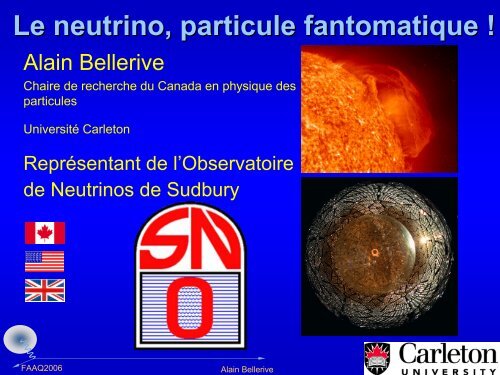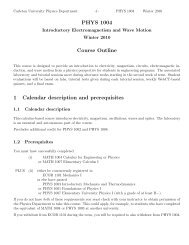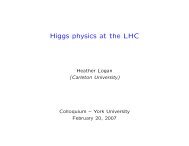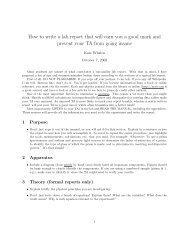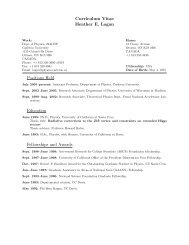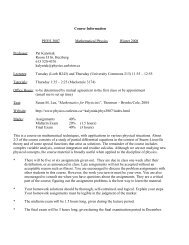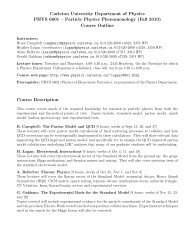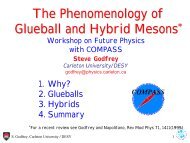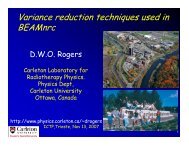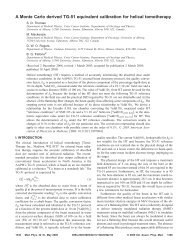E - Carleton University
E - Carleton University
E - Carleton University
Create successful ePaper yourself
Turn your PDF publications into a flip-book with our unique Google optimized e-Paper software.
Le neutrino, particule fantomatique !<br />
Alain Bellerive<br />
Chaire de recherche du Canada en physique des<br />
particules<br />
Université <strong>Carleton</strong><br />
Représentant de l’Observatoire<br />
de Neutrinos de Sudbury<br />
FAAQ2006 Alain Bellerive 1
Pourquoi l’étude des neutrinos !?!<br />
31 ième Congrès de la FAAQ 2006:<br />
• Plaisir – Curiosité – Passion<br />
• Science d’observation<br />
• Physique et astronomie<br />
Le neutrino:<br />
• La particule la plus abondante dans l’univers<br />
après le photon<br />
• Nos origines et la fabrique de l’espace/temps<br />
• Mieux comprendre la matière et les lois<br />
fondamentales qui gouvernent le cosmos<br />
L’Observatoire de Neutrinos de Sudbury:<br />
• Étoiles… sources de neutrinos<br />
• Étude de notre soleil<br />
• Implication en physique subatomique<br />
FAAQ2006 Alain Bellerive 2<br />
F<br />
U<br />
N<br />
S<br />
C<br />
I<br />
E<br />
N<br />
C<br />
E<br />
!
Les grandes questions du 21 ième siècle<br />
en astrophysique des particules<br />
• Comment les particules acquièrent-elles leur masse ?<br />
• Qu’est-ce que la masse manquante de l’univers ?<br />
• Pourquoi la matière domine-t-elle l’antimatière ?<br />
• Comment la matière a-t-elle évolué juste après<br />
le big bang ?<br />
FAAQ2006 Alain Bellerive 3
Sommaire<br />
• Introduction<br />
Forces fondamentales de la nature<br />
Le Modèle Standard de la physique des<br />
particules<br />
Histoire du neutrino<br />
Outils: détecteurs de particules<br />
• L’ABC de l’Interaction électrofaible<br />
• La physique au cœur du soleil<br />
• Le fameux problème des neutrinos solaires<br />
• L’appareil expérimental: ONS / SNO<br />
• Les résultats sur l’oscillation des neutrinos<br />
• La connexion cosmique<br />
• Le futur<br />
Alain FAAQ2006 Bellerive, <strong>Carleton</strong> <strong>University</strong><br />
Alain Bellerive 4
The First Piece:<br />
- Fundamental Forces<br />
- Standard Model<br />
-The Neutrino<br />
- Particle Detectors<br />
FAAQ2006 Alain Bellerive 5
Fundamental Forces<br />
Gravity: Gravity governs the<br />
attraction between two massive<br />
objects. It is negligible at the<br />
subatomic scale.<br />
Electromagnetic: Most of us<br />
are familiar with electric and<br />
magnetic phenomena.<br />
Strong: In the Standard Model,<br />
hadrons (neutrons & protons) are<br />
considered to be made of quarks<br />
bound together by the strong<br />
force.<br />
Weak: The weak interaction is<br />
more subtle! It is responsible for<br />
the instability of some nuclei via<br />
β-decay (e.g.(<br />
n -> > p e ν).<br />
Interaction<br />
EM<br />
Strong<br />
Weak<br />
Particle<br />
photon<br />
Range (m)<br />
Coupling<br />
infinity 10 -2<br />
gluon 10 -15<br />
1<br />
W & Z 10 -18<br />
10 -6<br />
FAAQ2006 Alain Bellerive 6
Scope of Particle Physics<br />
FAAQ2006 Alain Bellerive 7
Standard Model<br />
The Standard Model provides a<br />
general description of the physics<br />
currently accessible with modern<br />
particle accelerators. The minimal<br />
Standard Model postulates that<br />
matter is composed of fundamental<br />
spin-½ quarks and spin-½ leptons<br />
interacting via spin-1 bosons.<br />
FAAQ2006 Alain Bellerive 8
History of the Neutrino<br />
• Disovery of radioactivity by Marie and Pierre<br />
Curie (Nobel Price in Physics 1903)<br />
• Beta Decay: nucleus emit an electron or a<br />
positron when n → p e - or p → n e +<br />
FAAQ2006 Alain Bellerive 9
History of the Neutrino<br />
• In 1931, the neutrino was postulated by the theorist<br />
Wolfgang Pauli. Pauli based his prediction on the fact<br />
that energy and momentum did not appear to be<br />
conserved in certain radioactive decays. Pauli<br />
suggested that this missing energy might be carried<br />
off by an invisible neutral particle.<br />
• Later Enrico Fermi takes the neutrino hypothesis and<br />
builds his theory of beta decay (weak interaction).<br />
• Clyde Cowan and Fred Reines announced in 1959 the<br />
discovery of a particle fitting the expected<br />
characteristics of the neutrino. This neutrino is later<br />
determined to be the partner of the electron.<br />
FAAQ2006 Alain Bellerive 10
Elementary Particles<br />
electron<br />
&<br />
neutrino<br />
proton<br />
&<br />
neutron<br />
pion (π)<br />
&<br />
kaon<br />
Carried by →<br />
Acts on →<br />
Gravity<br />
Graviton<br />
(not yet observed)<br />
All Massive<br />
Weak<br />
Electromagnetic<br />
Electroweak<br />
W + W - Z 0<br />
Quarks and<br />
Leptons<br />
Photon<br />
Quarks and<br />
Charged Leptons<br />
and W + W -<br />
Strong<br />
Gluon<br />
Quarks and<br />
Gluons<br />
FAAQ2006 Alain Bellerive 11
Quarks and leptons can be sub-divided into families<br />
which interact via the exchange of weak vector bosons<br />
Quark Sector<br />
Lepton Sector<br />
Q = +2/3<br />
Q = -1/3<br />
⎛<br />
⎜⎜<br />
⎝<br />
u<br />
d<br />
⎞<br />
⎟⎟<br />
⎠<br />
⎛<br />
⎜⎜<br />
⎝<br />
c<br />
s<br />
⎞<br />
⎟⎟<br />
⎠<br />
⎛<br />
⎜⎜<br />
⎝<br />
t<br />
b<br />
⎞<br />
⎟⎟<br />
⎠<br />
⎛<br />
⎜<br />
⎝<br />
e<br />
ν e<br />
⎞<br />
⎟<br />
⎠<br />
⎛ μ ⎞<br />
⎜ ⎟<br />
⎝ν<br />
⎠<br />
⎛ τ ⎞<br />
⎜<br />
⎟<br />
⎝ ⎠<br />
μ ν τ<br />
Q = -1<br />
Q = 0<br />
Neutrinos only Electroweak interact via Lagrangian: the weak force since<br />
L = L(weak they NC) have + no L (em electric NC) charge! + L(weak CC)<br />
L ( em NC) = e<br />
J em<br />
A μ<br />
μ<br />
g<br />
L( weak NC)<br />
μ<br />
+<br />
cosθ<br />
(<br />
0 2 em<br />
= J sin θ J ) Z<br />
μ<br />
(<br />
+ μ−<br />
− μ+<br />
L(weak<br />
CC) = J W + J W )<br />
W<br />
W<br />
μ<br />
FAAQ2006 Alain Bellerive 12<br />
g<br />
2<br />
μ<br />
μ
Open Questions in Neutrino Physics<br />
In the theoretical framework of the<br />
Standard Model, there are presently<br />
two fundamental open questions at<br />
the forefront of neutrino physics<br />
1) The Solar Neutrino Problem !<br />
2) Are neutrinos massless ?<br />
3) Neutrino mixing and CP violation<br />
FAAQ2006 Alain Bellerive 13
Tools to study<br />
subatomic<br />
particles<br />
Δx<br />
Δp<br />
≈ h<br />
1) Multipurpose<br />
detectors operating<br />
at high energy<br />
accelerators<br />
e.g. ATLAS - ILC<br />
FAAQ2006 Alain Bellerive 14
2) Underground laboratories: e.g. Sudbury<br />
FAAQ2006 Alain Bellerive 15
The Second Piece:<br />
Electroweak Reactions<br />
FAAQ2006 Alain Bellerive 16
Electroweak Interactions<br />
L ( em NC) = e<br />
with<br />
f = e, μ,<br />
τ , ν , ν μ<br />
, ν ,<br />
J em<br />
A μ<br />
g<br />
L( weak NC) =<br />
μ<br />
+<br />
cosθ<br />
e<br />
τ<br />
W<br />
μ<br />
u, c, t,d,s, b<br />
f<br />
f<br />
(<br />
0 2 em<br />
J sin θ J ) Z<br />
μ<br />
W<br />
μ<br />
γ<br />
Z<br />
0<br />
f<br />
f<br />
+<br />
W or W<br />
−<br />
ν<br />
l<br />
or ν l<br />
+<br />
W or W<br />
−<br />
q′<br />
+ −<br />
l or l<br />
L(weak<br />
with l = e, μ , τ<br />
CC) =<br />
g<br />
2<br />
(<br />
+ μ−<br />
− μ+<br />
J W + J W )<br />
μ<br />
μ<br />
FAAQ2006 Alain Bellerive 17<br />
q<br />
with q = u,c, t and q′<br />
= d,s,b
Electroweak Reactions<br />
n → p e<br />
-<br />
ν e<br />
1) The neutron (charge = 0) is<br />
made of up, down, down quarks.<br />
2) One of the down quarks is<br />
transformed into an up type<br />
quark….<br />
Since the down quark has a charge of -1/3 and and the up quark has a charge of 2/3,<br />
it follows that this process is mediated by a virtual W - particle.<br />
3) The new up quark rebounds away from the emitted W - . The neutron now<br />
has become a proton.<br />
In this decay the W - particle,<br />
which carries away a (-1) charge;<br />
thus charge is conserved!<br />
4) An electron and antineutrino emerge from the virtual W- boson.<br />
5) The proton, electron, and the antineutrino move away from one another.<br />
FAAQ2006 Alain Bellerive 18
• Define a quark mixing<br />
matrix which relates the<br />
mass and weak<br />
eigenstates<br />
Quark Mixing (CKM)<br />
Quark Mixing Matrix<br />
• In the minimal Standard<br />
Model CP violation in the<br />
quark sector is built in the<br />
CKM matrix since the<br />
elements of V are<br />
complex<br />
⎛d′<br />
⎞<br />
⎜ ⎟<br />
⎜ s′<br />
⎟ =<br />
⎜ ⎟<br />
⎝b′<br />
⎠<br />
⎛V<br />
⎜<br />
⎜V<br />
⎜<br />
⎝V<br />
ud<br />
cd<br />
td<br />
V<br />
V<br />
V<br />
us<br />
cs<br />
ts<br />
V<br />
V<br />
V<br />
ub<br />
cb<br />
tb<br />
⎞ ⎛d⎞<br />
⎟ ⎜ ⎟<br />
⎟ ⎜ s ⎟<br />
⎟ ⎜ ⎟<br />
⎠ ⎝b⎠<br />
FAAQ2006 Alain Bellerive 19
Neutrino Mixing<br />
• Just as in the quark<br />
sector, it is possible to<br />
define a neutrino mixing<br />
matrix which relates the<br />
mass and weak<br />
eigenstates<br />
• In the minimal Standard<br />
Model there is NO<br />
neutrino mixing...<br />
Neutrino Mixing Matrix<br />
⎛νe<br />
⎞ ⎛U<br />
⎜ ⎟ ⎜<br />
⎜ν<br />
μ ⎟ = ⎜U<br />
⎜ ⎟ ⎜<br />
⎝ντ<br />
⎠ ⎝U<br />
e1<br />
μ1<br />
τ1<br />
U<br />
U<br />
U<br />
e2<br />
μ2<br />
τ 2<br />
U<br />
U<br />
U<br />
e3<br />
μ3<br />
τ3<br />
⎞ ⎛ν1<br />
⎞<br />
⎟ ⎜ ⎟<br />
⎟ ⎜ν<br />
2 ⎟<br />
⎟ ⎜ ⎟<br />
⎠ ⎝ν<br />
3 ⎠<br />
FAAQ2006 Alain Bellerive 20
Evidence for<br />
Neutrino Oscillations<br />
~30 kilometers<br />
μ+<br />
π +<br />
Cosmic-ray<br />
shower<br />
π 0<br />
First evidence of neutrino oscillation<br />
νe<br />
e+<br />
νμ<br />
ν μ<br />
ν μ<br />
ν e<br />
≠ 2<br />
Atmospheric Neutrinos<br />
high energies<br />
Underground<br />
ν e , ν e , ν μ , ν μ<br />
detector<br />
Atmospheric neutrino source<br />
π+ μ+ + ν μ<br />
e+ + ν e + ν μ<br />
π– μ– + νμ<br />
e – + νe + νμ<br />
Sun<br />
Solar<br />
core<br />
Primary neutrino source<br />
p + p D + e+ + νe<br />
~10 8 kilometers<br />
Earth<br />
Underground<br />
νe detector<br />
Solar Neutrinos<br />
low energies<br />
Today’s talk !!! !!!<br />
Proton<br />
beam<br />
Water<br />
target<br />
Pions<br />
Muons and electrons<br />
Copper beam stop<br />
Neutrinos<br />
ν e , ν μ , and ν μ<br />
30 meters<br />
ν e detector<br />
Neutrino Beams<br />
and Reactors<br />
Tunable energies<br />
and distances!<br />
FAAQ2006 Alain Bellerive 21
Arranging the Pieces:<br />
Solar Neutrino Physics<br />
FAAQ2006 Alain Bellerive 22
Macroscopic Properties of the Sun<br />
Mean Distance from the Earth: 1.5 x 10 11 m<br />
Mass: 2 x 10 30 kg<br />
Radius: 6.96 x 10 8 m<br />
Luminosity: 3.8 x 10 26 W<br />
Neutrino flux: 6.5 x 10 11 cm -2 s -1<br />
FAAQ2006 Alain Bellerive 23
Neutrino Production in the Sun<br />
Light Element Fusion Reactions<br />
p + p → 2 H + e + + ν e<br />
p + e - + p → 2 H + ν e<br />
0.25 %<br />
3<br />
He + p → 4 He + e + + ν e<br />
~10 -5 %<br />
15 %<br />
8<br />
B → 8 Be* + e + + ν e 0.02 %<br />
7<br />
Be + e - → 7 Li + ν e<br />
99.75 %<br />
Sun<br />
Earth<br />
Solar<br />
Undergroun<br />
core<br />
~10 8 kilometers<br />
ν e detector<br />
Primary neutrino source<br />
FAAQ2006 p + p D + e + Alain + ν e Bellerive 24
Neutrino Production in the Sun<br />
Light Element Fusion Reactions<br />
Neutrino Production Radius<br />
p + p → 2 H + e + + ν e 99.75 %<br />
p + e - + p → 2 H + ν e<br />
0.25 %<br />
3<br />
He + p → 4 He + e + + ν e<br />
~10 -5 %<br />
7<br />
Be + e - → 7 Li + ν e 15 %<br />
8<br />
B → 8 Be* + e + + ν e 0.02 %<br />
Sun<br />
Earth<br />
Solar<br />
Undergroun<br />
core<br />
~10 8 kilometers<br />
ν e detector<br />
Primary neutrino source<br />
FAAQ2006 p + p D + e + Alain + ν e Bellerive 25
Neutrino from the Sun<br />
• Our sun emits around 2 x 10 +38 neutrinos per second.<br />
• The earth receives more than 100 billions neutrinos<br />
per second and cm 2 . This huge raining is undetected by<br />
the five senses of the homo sapiens.<br />
Neutrino Detectors<br />
• Underground, undersea or under ice, the experimental<br />
apparatus detect either the Cerenkov light emitted when<br />
a neutrino interact with the water or the transformation<br />
of atoms under neutrino interaction.<br />
Strategy<br />
• Deep and clean = low background.<br />
• HUGE = Neutrino have small probability of interacting!<br />
FAAQ2006 Alain Bellerive 26
Solar Neutrino Experiments<br />
• Review of the Solar Standard Model (SSM)<br />
ν How e<br />
are produced and detected ?<br />
• Radiochemical experiments: Chlorine – Gallium<br />
• SuperKamiokande (some preliminary results)<br />
• Sudbury Neutrino Observatory (Latest Results)<br />
FAAQ2006 Alain Bellerive 27
Solar ν Flux and Experimental Sensitivity<br />
FAAQ2006 Alain Bellerive 28
Chlorine Measurements: Homestake (USA)<br />
• 1960’s: 37 Cl + ν e → 37 Ar + e -<br />
Construction of the Chlorine<br />
detector by Ray Davis<br />
• Depth: 4850 ft<br />
• Detector fluid: 3.8 x 10 5 l of C 2 Cl 4<br />
• Energy Thresold: 0.814 MeV<br />
• 1970 – 1995<br />
Measurements of solar ν flux<br />
Sensitive to 8 B & 7 Be ν’s<br />
• Observed rate (SNU)<br />
2.56 ± 0.16(stat) ± 0.16(syst)<br />
• Expected rate (SNU)<br />
+1.8<br />
8.5 [1σ from BP2004]<br />
–1.8<br />
Cleveland et al.,Ap. J. 496, 505(1998)<br />
FAAQ2006 Alain Bellerive 29
Gallium Experiments<br />
71<br />
Ga + ν e → 71 Ge + e -<br />
Radiochemical Target<br />
Small proportional counters are<br />
used to count the Germanium<br />
Energy Threshold: 0.233 MeV<br />
Sensitive to pp, 7 Be, 8 B, CNO,<br />
and pep ν’s<br />
SAGE: Russian-American<br />
Gallium solar neutrino<br />
Experiment (INR RAS)<br />
‣ A liquid metal target which<br />
contains 50 tons of gallium.<br />
GALLEX/GNO: Gallium Neutrino<br />
Observatory in<br />
Gran Sasso<br />
‣ 30 tons of natural gallium in<br />
an aqueous acid solution.<br />
FAAQ2006 Alain Bellerive 30
Gallium Measurements: SAGE (on-going)<br />
SAGE overall 1990-2003 (121 runs)<br />
66.9 ±3.9 (stat) ±3.6 (syst) SNU<br />
Expected rate [1σ from BP2004]<br />
+12<br />
131 SNU<br />
–10<br />
Source: Neutrino 2004<br />
FAAQ2006 Alain Bellerive 31
Gallium Measurements<br />
GALLEX<br />
65 Solar runs = 1594 d<br />
23 Blank runs<br />
77.5 ±6.2<br />
±4.5 SNU<br />
GNO (terminated)<br />
58 Solar runs = 1713 d<br />
12 Blank runs<br />
+5.5<br />
62.9 ± 2.5 SNU<br />
–5.3<br />
Expected rate [1σ from BP2004]<br />
+12<br />
131 SNU<br />
–10<br />
Source: Neutrino 2004<br />
FAAQ2006 Alain Bellerive 32
Water Detector: Super-Kamiokande<br />
(Japan)<br />
• 8 B neutrino measurement by<br />
ν x + e - → ν x + e -<br />
• Sensitive to ν e , ν μ , ν τ<br />
σ(ν μ,τ + e - ) ≈ 0.15 x σ(ν e + e - )<br />
• High statistics ~15ev./day<br />
• Real time measurement allow<br />
studies on time variations<br />
• Studies energy spectrum<br />
• 50 ktons of pure water with 11,146<br />
PMTs (fiducial volume<br />
of 22.5 ktons for analysis)<br />
FAAQ2006 Alain Bellerive 33
Solar neutrino data in SK (period I)<br />
Event/day/kton/bin<br />
0.2<br />
May 31, 1996 – July 13, 2001 (1496 days )<br />
SK-I 1496day 5.0-20MeV 22.5kt<br />
(Preliminary)<br />
ν<br />
e -<br />
θ sun<br />
0.1<br />
22400±230 solar ν events<br />
E e = 5.0 - 20 MeV<br />
0<br />
-1 -0.5 0 0.5 1<br />
cosθ sun<br />
8<br />
B flux : 2.35 ± 0.02 ± 0.08 [x 10 6 /cm 2 /sec]<br />
Data<br />
SSM(BP2004)<br />
= 0.406<br />
±0.004 +0.014<br />
–0.013<br />
FAAQ2006 Alain Bellerive 34
Solar ν Flux Measurement Results<br />
Chlorine – Gallium – Water experiments<br />
have<br />
different energy threshold<br />
!!! The data suggest an energy dependence !!!<br />
??? What could explain such a variation ???<br />
FAAQ2006 Alain Bellerive 35
Solar ν Flux Measurement Results<br />
PROBLEM !<br />
Chlorine – Gallium – Water experiments<br />
have<br />
different energy threshold<br />
!!! The data suggest an energy dependence !!!<br />
??? What could explain such a variation ???<br />
FAAQ2006 Alain Bellerive 36
Solar Neutrino Problem<br />
• Historically the first culprit was assumed to be the<br />
method of determining the solar ν flux.<br />
• In fact, the last 30 years showed that the SSM provides<br />
and accurate description of the macroscopic properties<br />
of our Sun.<br />
• The mass, radius, shape, luminosity, age, chemical<br />
composition, and photon spectrum of the Sun are<br />
precisely determined and used as input parameters.<br />
• Equation of state relates pressure and density; while<br />
the radiative opacity dictates photon transport.<br />
• Experimental fusion cross sections used to determined<br />
the nuclear reaction rates.<br />
FAAQ2006 Alain Bellerive 37
Test of Standard Solar Model<br />
SSM determines the<br />
present distribution<br />
of physical variables<br />
inside the Sun (like<br />
the core temperature<br />
and density), photon<br />
spectrum, the speed<br />
of sound, , and the<br />
neutrino fluxes.<br />
(Model-Sun)/Sun<br />
Fractional differences between the calculated<br />
sound speeds for the SSM and the accurate<br />
sound speeds measured by helioseismology,<br />
R/R sun<br />
FAAQ2006 Alain Bellerive 38
Neutrino Oscillations<br />
Neutrino States<br />
Mass States states<br />
Weak States states<br />
First Second First Second<br />
ν 1<br />
ν 2<br />
ν e<br />
ν μ<br />
ν μ<br />
ν 2<br />
ν 1<br />
sinθ<br />
θ<br />
cosθ<br />
θ<br />
ν e<br />
⎛ν<br />
e ν e cosθ (<br />
⎞<br />
ν<br />
) ⎛=( cosθ<br />
sinθ<br />
ν<br />
μ<br />
2sinθ cosθ<br />
)( ⎞ ⎛ 1<br />
ν<br />
ν<br />
) 1 ⎞<br />
⎜ ⎟<br />
= ⎜<br />
⎟<br />
⎜ 2<br />
⎟<br />
⎝ν<br />
μ ⎠ ⎝−<br />
sinθ<br />
cosθ<br />
⎠ ⎝ν<br />
2 ⎠<br />
Time Evolution<br />
Pure ν μ<br />
Pure ν μ<br />
Pure ν μ<br />
i<br />
d<br />
dt<br />
⎛ν<br />
e ⎞<br />
⎜ ⎟<br />
=<br />
⎝ν<br />
⎠<br />
1<br />
2<br />
⎛ν<br />
e ⎞<br />
T ⎜ ⎟<br />
⎝ ⎠<br />
μ<br />
ν μ<br />
ν 2<br />
2<br />
⎛ Δm<br />
Δm<br />
⎜−<br />
cos 2θ<br />
T = ⎜ 2E<br />
2E<br />
⎜ 2<br />
2<br />
Δm<br />
2 Δm<br />
⎜ sin θ<br />
⎝ 2E<br />
2E<br />
2<br />
2<br />
2<br />
⎞<br />
sin θ ⎟<br />
⎟<br />
⎟<br />
cos 2θ<br />
⎟<br />
⎠<br />
0<br />
ν 1<br />
Time, t<br />
FAAQ2006 Alain Bellerive 39
Neutrino Oscillations:<br />
Δm<br />
2<br />
=<br />
m<br />
2<br />
2<br />
−m<br />
2<br />
1<br />
P ee ~ sin 2 (2θ) sin 2 (1.27Δm 2 L / E)<br />
• Physics:<br />
Δm 2 & sin(2θ)<br />
• Experiment:<br />
Distance (L) & Energy (E)<br />
ν μ<br />
e<br />
The state evolve with time or distance<br />
FAAQ2006 Alain Bellerive 40
Solar Neutrino Oscillations<br />
P ee = sin 2 (2θ) sin 2 (1.27Δm 2 L / E)<br />
• Physics:<br />
Δm 2 & sin(2θ)<br />
• Experiment:<br />
Distance (L) & Energy (E)<br />
Δm<br />
2<br />
3 Parameters !<br />
Δm<br />
≡ Δm<br />
2<br />
=<br />
2<br />
12<br />
m<br />
andθ ≡θ<br />
2<br />
2<br />
−<br />
m<br />
12<br />
2<br />
1<br />
θ = Mixing angle<br />
⎛<br />
⎜<br />
⎜<br />
⎝<br />
ν e<br />
ν μ<br />
ν τ<br />
⎞ ⎛ U e1<br />
U e2<br />
U e3<br />
⎟<br />
⎟ = ⎜<br />
U μ1<br />
U μ2<br />
U μ3<br />
⎜<br />
⎠ ⎝ U τ1<br />
U τ2<br />
U τ3<br />
⎞<br />
⎟<br />
⎟<br />
⎠<br />
⎛<br />
⎜<br />
⎜<br />
⎝<br />
ν 1<br />
ν 2<br />
ν 3<br />
⎞<br />
⎟<br />
⎟<br />
⎠<br />
The state evolves with<br />
time or distance<br />
FAAQ2006 Alain Bellerive 41
Mixing<br />
Parameters<br />
LMA<br />
Combination of the<br />
Chlorine, Gallium,<br />
SK, and CHOOZ<br />
restricted the mixing<br />
parameters<br />
Pre SNO<br />
Δm 2 (eV 2 )<br />
SMA<br />
Allowed Regions<br />
LOW<br />
VAC<br />
JustSo 2<br />
Phys.Rev. D64 (2001) 093007<br />
tan 2 θ<br />
FAAQ2006 Alain Bellerive 42
Matter-Enhanced Neutrino Oscillations<br />
Neutrinos produced in weak P ee<br />
state ν e<br />
⇒ High density of electrons in<br />
the Sun<br />
⇒ Superposition of mass states<br />
ν 1, 2, 3 changes through the<br />
MSW resonance effect<br />
⇒ Solar neutrino flux detected<br />
on Earth consists of ν e + ν μ,τ<br />
FAAQ2006 Alain Bellerive 43
Mixing<br />
Parameters<br />
LMA<br />
Combination of the<br />
Chlorine, Gallium,<br />
SK, and CHOOZ<br />
restricted the mixing<br />
parameters<br />
Pre SNO<br />
Δm 2 (eV 2 )<br />
SMA<br />
Allowed Regions<br />
LOW<br />
VAC<br />
JustSo 2<br />
Phys.Rev. D64 (2001) 093007<br />
tan 2 θ<br />
FAAQ2006 Alain Bellerive 44
Somewhere in the Depths of<br />
Canada...<br />
FAAQ2006 Alain Bellerive 45
SNO Timeline<br />
1998 1999 2000 2001 2002 2003 2004 2005 2006<br />
Commissioning<br />
D 2 O<br />
D 2 O + Salt<br />
D 2 O<br />
D 2 O + 3 He counters<br />
• Phase 1: D 2 O<br />
• Phase 2: D 2 O + Salt (NaCl)<br />
3<br />
He counters: Install &<br />
Commission<br />
• Phase 1a: D 2 O<br />
• Phase 3: D 2 O + 3 He counters<br />
FAAQ2006 Alain Bellerive 46
Underground laboratory in Sudbury<br />
SNOLAB<br />
FAAQ2006 Alain Bellerive 47
The SNO Detector during Construction<br />
FAAQ2006 Alain Bellerive 48
Subury Neutrino Observatory<br />
• Timeline<br />
• Experimental Apparatus<br />
• First Results from the D 2 0 Phase<br />
• Most Recent Results from the Salt<br />
Phase<br />
• Outlook to the new NCD Phase<br />
OVERAL PICTURE<br />
FAAQ2006 Alain Bellerive 49
Sudbury Neutrino Observatory (Canada)<br />
2092 m to Surface (6010 m w.e.)<br />
PMT Support Structure, 17.8 m<br />
9456 20 cm PMTs<br />
~55% coverage within 7 m<br />
Acrylic Vessel, 12 m diameter<br />
1000 tonnes D 2 O<br />
1700 tonnes H 2 O, Inner Shield<br />
5300 tonnes H 2 O, Outer Shield<br />
Urylon Liner and Radon Seal<br />
Energy Threshold = 5.511 MeV<br />
FAAQ2006 Alain Bellerive 50
Purpose of SNO<br />
• If Solar Neutrino Problem due to ν e<br />
flavour oscillation mixing to ν μ and/or ν τ , SNO should<br />
provide direct evidence .<br />
• SNO measures flux of ν e and flux of<br />
(ν e +ν μ +ν τ ).<br />
• Previous expt’s sensitive to only ν e or<br />
mainly ν e .<br />
Water Čerenkov expt’s:<br />
Kamiokande, Super-K<br />
Radiochemical expt’s:<br />
37<br />
Cl at Homestake and<br />
71<br />
Ga at Gran Sasso/Baksan<br />
FAAQ2006 Alain Bellerive 51
Solar Neutrino Events in SNO<br />
SNO<br />
Heavy Water<br />
Cherenkov Detector<br />
Cherenkov Light<br />
When a particle travels through a medium such<br />
that its velocity v is greater that the velocity<br />
of light in the medium c/n, radiation is emitted.<br />
The radiation is confined to a CONE around the<br />
direction of the incident particle.<br />
FAAQ2006 Alain Bellerive 52
Neutrino detection in SNO<br />
• PMTs detect<br />
Čerenkov<br />
photons<br />
from relativistic e - :<br />
– e - from CC or ES<br />
reaction<br />
e -<br />
43 o<br />
– γ from<br />
from n-capture<br />
(NC reaction)<br />
usually ComptonC<br />
ompton-<br />
scatters e - (pair<br />
production less<br />
likely).<br />
Čerenkov cone<br />
FAAQ2006 Alain Bellerive 53
Neutrino detection in SNO<br />
• Hit pattern from<br />
Čerenkov<br />
cone<br />
indicates physics<br />
event.<br />
• PMT hit times and<br />
locations used to<br />
reconstruct e -<br />
direction and<br />
location<br />
• Number of PMT hits<br />
used to estimate<br />
electron energy.<br />
FAAQ2006 Alain Bellerive 54
SNO observables - event by event<br />
PMT Information: Positions, Charges, Times<br />
Event Reconstruction<br />
Vertex, Direction, Energy, Isotropy<br />
FAAQ2006 Alain Bellerive 55
The SNO detector observes the following<br />
interactions:<br />
CC<br />
Charged Current<br />
ν e + d → p + p + e −<br />
ν e<br />
d<br />
p<br />
p<br />
e −<br />
ES<br />
Elastic Scattering<br />
ν x + e − →ν x + e −<br />
ν x<br />
ν x<br />
e − e −<br />
NC<br />
Neutral Current<br />
ν x<br />
ν x + d → ν x + p + n<br />
ν x<br />
p<br />
d<br />
n<br />
x = e , μ , τ<br />
Detected<br />
Particle<br />
FAAQ2006 Alain Bellerive 56
Neutrino Reactions in SNO<br />
CC<br />
ν e d → p + p +<br />
x+<br />
e −<br />
- Q = 1.445 MeV<br />
- good measurement of ν e<br />
energy spectrum<br />
- some directional info ∝ (1 – 1/3 cosθ)<br />
- ν e<br />
only<br />
Produces Cherenkov<br />
Light Cone in D 2 O<br />
NC<br />
ν + d → p + n +<br />
x<br />
ν x<br />
- Q = 2.22 MeV<br />
- measures total 8 B ν flux from the Sun<br />
- equal cross section for all ν types<br />
+ → e −<br />
ES ν e − ν +<br />
x<br />
- low statistics<br />
- mainly sensitive to ν e<br />
, some ν μ<br />
and ν τ<br />
- strong directional sensitivity<br />
n captures on deuteron<br />
2<br />
H or 35 Cl or 3 He<br />
Produces Cherenkov<br />
Light Cone in D 2 O<br />
FAAQ2006 Alain Bellerive 57
Heavy water and neutrino interaction in SNO<br />
SNO measures flux of φ CC = ν e<br />
and<br />
the total flux φ NC = (ν e +ν μ +ν τ )<br />
φ CC ≠ φ NC → oscillation<br />
FAAQ2006 Alain Bellerive 58
An Ultraclean Environment<br />
• Highly sensitive to<br />
any γ above neutral<br />
current (2.2 MeV)<br />
threshold.<br />
Thorium<br />
2.615 MeV γ<br />
• Sensitive to 238 U<br />
& 232 Th decay chains<br />
FAAQ2006 Alain Bellerive 59
An Ultraclean Environment<br />
• Highly sensitive to<br />
any γ above neutral<br />
current (2.2 MeV)<br />
threshold.<br />
Uranium<br />
3.27 MeV β<br />
• Sensitive to 238 U<br />
& 232 Th decay chains<br />
FAAQ2006 Alain Bellerive 60
Three Ways to Catch Neutrons!<br />
(NC) + d →ν<br />
x<br />
+ p +<br />
ν x<br />
n<br />
Pure D 2<br />
O Salt 3<br />
He<br />
Nov. 99 - May 01 July 01 - Aug. 03<br />
Summer 04 - Dec. 06<br />
n<br />
n captures on<br />
deuterium<br />
σ = 0.0005b<br />
6.2 MeV γ<br />
3<br />
H*<br />
γ<br />
2<br />
H 3<br />
H<br />
PRL 87, 071301, 2001<br />
PRL 89, 011301, 2002<br />
PRL 89, 011302, 2002<br />
n captures on<br />
chlorine<br />
σ = 44b<br />
8.6 MeV multiple γ’s<br />
n<br />
36<br />
Cl*<br />
35<br />
Cl 36<br />
Cl<br />
PRL 92, 181301, 2004<br />
PRC 72,055502, 2005<br />
γ<br />
γ<br />
γ<br />
n captures on 3 He<br />
in discrete prop.<br />
counter array<br />
σ = 5330b<br />
0.764 MeV γ<br />
3<br />
H<br />
5 cm<br />
3<br />
He<br />
p<br />
n<br />
n + 3 He → p + 3 H<br />
FAAQ2006 Alain Bellerive 61
Global View:<br />
SNO Results<br />
FAAQ2006 Alain Bellerive 62
Subury Neutrino Observatory<br />
D 2 O Results (2002)<br />
The limitation and weakness ?!?!<br />
Used the energy PDF to<br />
statistically discriminate<br />
CC, ES, and NC<br />
Kinetic Energy (MeV)<br />
Assume and undistorded<br />
energy spectrum<br />
(Radius / AV Radius) 3<br />
In other words, a FLAT<br />
survival probability!!!<br />
cos θ sun<br />
FAAQ2006 Alain Bellerive 63
Shape Constrained Signal Extraction Results<br />
#EVENTS<br />
CC 1967.7 +61.9<br />
+60.9<br />
+26.4<br />
ES 263.6 +25.6<br />
+49.5<br />
NC 576.5 +48.9<br />
Events per 500 keV<br />
600<br />
500<br />
400<br />
300<br />
200<br />
(c)<br />
CC<br />
100 NC + bkgd<br />
Bkgd neutrons<br />
ES<br />
0<br />
5 6 7 8 9 10 11 12 13→ 20<br />
(MeV)<br />
T eff<br />
Events per 0.1 wide bin<br />
500<br />
400<br />
300<br />
200<br />
(b)<br />
Fiducial Volume<br />
Bkgd<br />
100 CC<br />
NC + bkgd neutrons<br />
ES<br />
0<br />
0 0.2 0.4 0.6 0.8 1 1.2<br />
3<br />
(R/R AV<br />
)<br />
Events per 0.05 wide bin<br />
160<br />
(a)<br />
140<br />
120<br />
100<br />
80<br />
60<br />
40<br />
CC<br />
ES<br />
20 NC + bkgd neutrons<br />
0<br />
Bkgd<br />
-1 -0.8 -0.6 -0.4 -0.2 -0 0.2 0.4 0.6 0.8 1<br />
cos θ sun<br />
FAAQ2006 Alain Bellerive 64
Shape Constrained Neutrino Fluxes (D 2 O)<br />
Signal Extraction in Φ CC , Φ NC , Φ ES with<br />
+0.06<br />
+0.09<br />
Φ cc (ν e ) = 1.76 -0.05 (stat.) -0.09 (syst.) x10 6 cm -2 s -1<br />
+0.24<br />
+0.12<br />
Φ es (ν x ) = 2.39 -0.23 (stat.) -0.12 (syst.) x10 6 cm -2 s -1<br />
+0.44<br />
+0.46<br />
Φ nc (ν x ) = 5.09 -0.43 (stat.) -0.43 (syst.) x10 6 cm -2 s -1<br />
Signal Extraction in Φ e , Φ μτ<br />
E Theshold > 5 MeV<br />
Φ cc (ν e ) = Φ e<br />
and Φ nc (ν x ) = Φ e + Φ μτ<br />
Φ es (ν x ) = (1- ε) Φ e + εΦ μτ with ε≈0.15<br />
FAAQ2006 Alain Bellerive 65
Shape Constrained Neutrino Fluxes (D 2 O)<br />
Signal Extraction in Φ CC , Φ NC , Φ ES with<br />
+0.06<br />
+0.09<br />
Φ cc (ν e ) = 1.76 -0.05 (stat.) -0.09 (syst.) x10 6 cm -2 s -1<br />
+0.24<br />
+0.12<br />
Φ es (ν x ) = 2.39 -0.23 (stat.) -0.12 (syst.) x10 6 cm -2 s -1<br />
+0.44<br />
+0.46<br />
Φ nc (ν x ) = 5.09 -0.43 (stat.) -0.43 (syst.) x10 6 cm -2 s -1<br />
Signal Extraction in Φ e , Φ μτ<br />
+0.05<br />
Φ cc (ν e ) -0.05 = Φ e<br />
+0.45<br />
+0.09<br />
E Theshold > 5 MeV<br />
Φ e = 1.76 (stat.) (syst.) x10 6 cm -2 s -1<br />
and -0.09<br />
Φ nc (ν x ) = Φ e + Φ μτ<br />
+0.48<br />
Φ μτ = 3.41 (stat.) (syst.) x10 6 cm -2 s -1<br />
Φ es (ν x ) = (1- ε) Φ e + εΦ -0.45<br />
-0.45<br />
μτ with ε≈0.15<br />
FAAQ2006 Alain Bellerive 66
SNO NC in D 2 O (April 2002)<br />
~ 2/3 of initial solar ν e are observed at SNO to be ν μ,τ<br />
s -1 )<br />
cm -2<br />
6<br />
(10<br />
φ μτ<br />
8<br />
7<br />
6<br />
5<br />
4<br />
3<br />
2<br />
1<br />
SNO<br />
φ ES<br />
SNO<br />
φ CC<br />
0<br />
0 1 2 3 4 5 6<br />
Phys. Rev. Lett. 89 (2002)<br />
SNO<br />
φ NC<br />
SSM<br />
φ NC<br />
φ e<br />
6<br />
(10<br />
-2<br />
cm<br />
-1<br />
s )<br />
Flavor change<br />
at 5.3 σ level.<br />
Sum of all the<br />
fluxes agrees<br />
with SSM.<br />
Φ SSM = 5.05 -0.81<br />
+1.01<br />
10 6 cm -2 s -1<br />
+0.44 +0.46<br />
Φ SNO = 5.09 -0.43 -0.43<br />
10 6 cm -2 s -1<br />
FAAQ2006 Alain Bellerive 67
The Solar Neutrino Problem<br />
Experiment Exp/SSM<br />
•SAGE+GALLEX/GNO 0.55<br />
•Homestake 0.34<br />
•Kamiokande+SuperK<br />
0.47<br />
•SNO CC (June 2001) 0.35<br />
SNO NC (April 2002) 1.01<br />
SNO CC vs NC implies flavor change, which can then<br />
explain other experimental results.<br />
FAAQ2006 Alain Bellerive 68
Progress in 2002<br />
on the Solar<br />
Neutrino Problem<br />
March 2002<br />
FAAQ2006 Alain Bellerive 69
Progress in 2002<br />
on the Solar<br />
Neutrino Problem<br />
March 2002<br />
April 2002<br />
with SNO<br />
LMA=Large Mixing Angle<br />
FAAQ2006 Alain Bellerive 70
Neutrino Mixing (detail)<br />
As in the quark sector<br />
one defines a neutrino<br />
mixing matrix which<br />
relates the mass and<br />
weak eigenstates<br />
⎛<br />
⎜<br />
⎜<br />
⎝<br />
ν e<br />
ν μ<br />
ν τ<br />
Mixing Matrix<br />
⎞ ⎛ U e1<br />
U e2<br />
U e 3<br />
⎟<br />
⎟ = ⎜<br />
U μ1<br />
U μ2<br />
U μ 3<br />
⎜<br />
⎠ ⎝ U τ1<br />
U τ 2<br />
U τ 3<br />
⎞<br />
⎟<br />
⎟<br />
⎠<br />
⎛<br />
⎜<br />
⎜<br />
⎝<br />
ν 1<br />
ν 2<br />
ν 3<br />
⎞<br />
⎟<br />
⎟<br />
⎠<br />
Quark:<br />
Neutrino:<br />
θ12 ≈ π /14 θ<br />
23<br />
≈ π / 76 yes θ13 ≈ π / 870<br />
θ ≈ / 6 θ ≈ / 4 ??? θ < / 20<br />
12<br />
π<br />
23<br />
π<br />
13<br />
π<br />
solar atmospheric CP violation short-baseline<br />
⎛ c<br />
⎜<br />
Uα<br />
i<br />
= ⎜−<br />
s<br />
⎜<br />
⎝ 0<br />
where c<br />
ij<br />
12<br />
12<br />
s<br />
c<br />
12<br />
12<br />
0<br />
= cosθ<br />
,<br />
ij<br />
0⎞<br />
⎛1<br />
⎟ ⎜<br />
0⎟⋅⎜0<br />
1⎟<br />
⎜<br />
⎠ ⎝0<br />
and s =<br />
ij<br />
c<br />
0<br />
23<br />
− s<br />
23<br />
sinθ<br />
ij<br />
s<br />
c<br />
0<br />
23<br />
23<br />
⎞ ⎛1<br />
⎟ ⎜<br />
⎟⋅⎜0<br />
⎟ ⎜<br />
⎠ ⎝0<br />
0<br />
1<br />
0<br />
0 ⎞ ⎛ c<br />
⎟ ⎜<br />
0 ⎟⋅⎜<br />
0<br />
e<br />
− iδ ⎟ ⎜<br />
⎠ ⎝−<br />
s<br />
13<br />
13<br />
0<br />
1<br />
0<br />
s<br />
c<br />
13<br />
0<br />
13<br />
⎞<br />
⎟<br />
⎟<br />
⎟<br />
⎠<br />
FAAQ2006 Alain Bellerive 71
The Nobel Prize in Physics 2002<br />
"for pioneering contributions<br />
to astrophysics, in particular<br />
for the detection of cosmic<br />
neutrinos"<br />
"for pioneering contributions<br />
to astrophysics, which have<br />
led to the discovery of cosmic<br />
X-ray sources"<br />
Raymond Davis Jr.<br />
Masatoshi Koshiba<br />
Riccardo Giacconi<br />
The work of Davis and Koshiba has<br />
led to unexpected discoveries and<br />
a new, intensive field of research,<br />
neutrino-astronomy.<br />
Giacconi constructed the first<br />
X-ray telescopes, which have<br />
provided us with completely<br />
new – and sharp – images of<br />
the universe.<br />
FAAQ2006 Alain Bellerive 72
Subury Neutrino Observatory<br />
Salt Results (391 days)<br />
PRC 72,055502, 2005<br />
FAAQ2006 Alain Bellerive 73
Flux results from fits<br />
Units for φ are 10 6 cm -2 s -1<br />
Standard Solar Model<br />
(Bahcall, Pinsonneault 2004)<br />
φ BP04 = 5.79 ± 1.33<br />
FAAQ2006 Alain Bellerive 74
Charged Current (CC=ν e ) Spectrum<br />
Kinetic Energy (MeV)<br />
FAAQ2006 Alain Bellerive 75
SNO: Salt results and comparison to SSM<br />
More precise salt results<br />
confirm D 2 O results<br />
FAAQ2006 Alain Bellerive 76
Day/Night Asymmetries<br />
A<br />
X<br />
=<br />
( Φ<br />
( Φ<br />
night<br />
night<br />
− Φ<br />
+ Φ<br />
day<br />
day<br />
)<br />
) / 2<br />
A CC = -0.056 ± 0.074 (stat.) ± 0.051 (syst.)<br />
A NC = 0.042 ± 0.086(stat.) ± 0.067 (syst.)<br />
A ES = 0.146 ± 0.198(stat.) ± 0.032 (syst.)<br />
A CC<br />
and A NC<br />
are correlated<br />
(ρ = -0.532)<br />
Kinetic Energy (MeV)<br />
In standard neutrino<br />
oscillations, A NC<br />
should be<br />
zero…<br />
FAAQ2006 Alain Bellerive 77
Solar neutrino oscillation parameters<br />
SNO data only<br />
D 2 O and Salt (2005)<br />
Allowed Regions<br />
Ratio of CC/NC fluxes gives P(ν e → ν e )<br />
P(ν e → ν e ) = 1- sin 2 (2θ)sin 2 (1.27Δm 2 L/E)<br />
FAAQ2006 Alain Bellerive 78
SNO: Results Phase II: neutrino<br />
oscillation parameters<br />
Solar data<br />
SNO data only<br />
Solar + KamLAND<br />
Ratio of CC/NC fluxes gives P(ν e → ν e )<br />
P(ν e → ν e ) = 1- sin 2 (2θ)sin 2 (1.27Δm 2 L/E)<br />
FAAQ2006 Alain Bellerive 79
Subury Neutrino Observatory<br />
NCD Phase<br />
FAAQ2006 Alain Bellerive 80
NCD Deployment<br />
FAAQ2006 Alain Bellerive 81
SNO at Present<br />
NC<br />
ν + d → p + n +<br />
x<br />
ν x<br />
n + 3 He → p + t<br />
Neutral Current Detectors<br />
ν x<br />
• Event by event separation<br />
• Break the correlation between<br />
NC & CC events<br />
• Measure in separate data<br />
streams NC & CC events<br />
• Different systematic errors<br />
than neutron capture on NaCl<br />
• Taking data until end of 2006<br />
n<br />
FAAQ2006 Alain Bellerive 82
What SNO might tell us in the future…<br />
LMA Allowed<br />
Day – Night<br />
Contours (%)<br />
CC/NC<br />
Contours<br />
hep-ph/0212270<br />
hep-ph/0204253<br />
FAAQ2006 Alain Bellerive 83
Canadian Foundation for Innovation (CFI) 50 M$ Investment<br />
Deep: 2092 m underground ⇒ 85 μ/mμ<br />
2 /y<br />
FAAQ2006 Alain Bellerive 84
FAAQ2006 Alain Bellerive 85
Outreach<br />
Scientific Program of SNOLAB<br />
• Low Energy Neutrinos<br />
‣ Sudbury Neutrino Observatory (SNO)<br />
‣ SNO++ (upgrade with liquid scintillator)<br />
• Search for Cold Dark Matter<br />
‣ Picasso<br />
‣ DEAP<br />
‣ SuperCDMS<br />
• Investigation of Double-Beta Decay<br />
‣ Majorana<br />
‣ Enriched Xenon Observatory (EXO)<br />
FAAQ2006 Alain Bellerive 86
Summary<br />
• SNO provided direct evidence of flavor conversion<br />
of solar ν e ’s – Neutrino is a massive particle !!!<br />
• Matter Effect explains the energy dependence of<br />
solar oscillation<br />
• Large mixing angle (LMA) solutions are favored<br />
• Solar Neutrino Problem is now an industry for<br />
precise measurements of neutrino oscillation<br />
parameters – SNO (d2o+salt+NCD) ultimate probe<br />
FAAQ2006 Alain Bellerive 87
Les grandes questions du 21 ième siècle<br />
en astrophysique des particules<br />
• Comment les particules acquièrent-elles leur masse ?<br />
• Qu’est-ce que la masse manquante de l’univers ?<br />
• Pourquoi la matière domine-t-elle l’antimatière ?<br />
• Comment la matière a-t-elle évolué juste après<br />
le big bang ?<br />
Quelle sont les implications des neutrinos<br />
massifs sur notre description de l’univers !?<br />
FAAQ2006 Alain Bellerive 88
Comment les particules acquièrent-elles<br />
leur masse ? Le Boson de Higgs !<br />
Large Hadron Collider at CERN (Switzerland)<br />
E = m c 2<br />
FAAQ2006 Alain Bellerive 89
Comment les particules acquièrent-elles<br />
leur masse ? ATLAS !<br />
FAAQ2006 Alain Bellerive 90
Qu’est-ce que la masse manquante de l’univers ?<br />
Cosmic Microwave Background (CMB) et<br />
Supernova et Large Scale Structure (clusters)<br />
FAAQ2006 Alain Bellerive 91
Qu’est-ce que la masse manquante de<br />
l’univers ? SUSY ! Neutralino ?<br />
Search for WIMP<br />
Weakly Interactive Massive<br />
Particle<br />
LHC<br />
FAAQ2006 Alain Bellerive 92
WIMP Interaction with Matter<br />
Spin independent interaction – scalar coupling<br />
M WIMP ~ 100 GeV<br />
heavy nuclei<br />
M Recoil < 100 keV<br />
Faint signals (heat, light, sound,<br />
electron)<br />
Clean and deap underground<br />
laboratory<br />
Low Energy Threshold<br />
Large Target Mass with<br />
Ultra-Low Background<br />
FAAQ2006 Alain Bellerive 93
What About Neutrino Mass?<br />
FAAQ2006 Alain Bellerive 94
Pourquoi la matière domine-t-elle<br />
l’antimatière ? Violation CP !<br />
Neutrinos?<br />
FAAQ2006 Alain Bellerive 95
Comment la matière a-t-elle évolué juste<br />
après le big bang ? WMAP<br />
Wilkinson Microwave Anisotropy Probe<br />
∑mν<br />
<<br />
( 1.6 − 3.1) eV (95% CL)<br />
FAAQ2006 Alain Bellerive 96
Conclusion<br />
• Plusieurs défis en astrophysique des particules<br />
• Le neutrino en est un bon exemple<br />
• Futur: ATLAS - SNOLAB - ILC<br />
• Plusieurs applications en haute technologie<br />
• Opportunités pour les jeunes (et les moins jeunes)<br />
scientifiques<br />
FIN<br />
FAAQ2006 Alain Bellerive 97
http://www.physics.carleton.ca/~alainb/<br />
http://www.ocip.carleton.ca<br />
FAAQ2006 Alain Bellerive 98
FAAQ2006 Alain Bellerive 99


